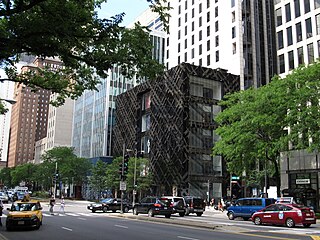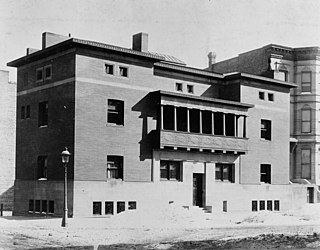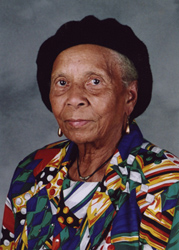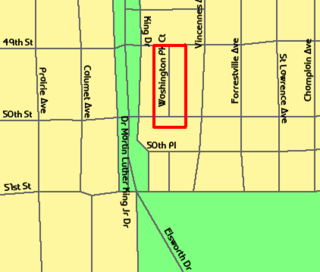
Riverside is a suburban village in Cook County, Illinois, United States. The population of the village was 9,298 at the 2020 census. It is a suburb of Chicago, located roughly 9 miles (14 km) west of downtown Chicago and 2 miles (3 km) outside city limits. A significant portion of the village is in the Riverside Landscape Architecture District, designated a National Historic Landmark in 1970.

Michigan Avenue is a north-south street in Chicago that runs at 100 east on the Chicago grid. The northern end of the street is at DuSable Lake Shore Drive on the shore of Lake Michigan in the Gold Coast Historic District. The street's southern terminus is at Sibley Boulevard in the southern suburb of Dolton, but like many other Chicago streets, it exists in several disjointed segments.

LaSalle Street is a major north-south street in Chicago named for René-Robert Cavelier, Sieur de La Salle, a 17th century French explorer of the Illinois Country. The portion that runs through the Chicago Loop is considered to be Chicago's financial district.

The James Charnley Residence, also known as the Charnley-Persky House, is a historic house museum at 1365 North Astor Street in the near northside Gold Coast neighborhood of Chicago, Illinois. Designed in 1891 and completed in 1892, it is one of the few surviving residential works of Adler & Sullivan.

The DuSable Black History Museum and Education Center, formerly the DuSable Museum of African American History, is a museum in Chicago that is dedicated to the study and conservation of African-American history, culture, and art. It was founded in 1961 by Margaret Taylor-Burroughs, her husband Charles Burroughs, Gerard Lew, Eugene Feldman, Bernard Goss, Marian M. Hadley, and others. They established the museum to celebrate black culture, at the time overlooked by most museums and academic establishments. The museum has an affiliation with the Smithsonian Institution.

The Harriet Beecher Stowe House is a historic house museum and National Historic Landmark at 73 Forest Street in Hartford, Connecticut that was once the home of Harriet Beecher Stowe, author of the 1852 novel Uncle Tom's Cabin. Stowe lived in this house for the last 23 years of her life. It was her family's second home in Hartford. The 5,000 sq ft cottage-style house is located adjacent to the Mark Twain House and is open to the public. It was listed on the National Register of Historic Places in 1970, and declared a National Historic Landmark in 2013.

Margaret Taylor-Burroughs, also known as Margaret Taylor Goss, Margaret Taylor Goss Burroughs or Margaret T G Burroughs, was an American visual artist, writer, poet, educator, and arts organizer. She co-founded the Ebony Museum of Chicago, now the DuSable Museum of African American History.

The Washington Park Court District is a Grand Boulevard community area neighborhood on the South Side of Chicago, Illinois. It was designated a Chicago Landmark on October 2, 1991. Despite its name, it is not located within either the Washington Park community area or the Washington Park park, but is one block north of both. The district was named for the Park.

The Chicago Defender Building, located at 3435 S. Indiana Avenue in the Black Metropolis-Bronzeville District of the Douglas community area of Chicago, Illinois, housed the Chicago Defender from 1920 until 1960. Designed by Henry L. Newhouse, it was originally a synagogue. The building was designated a Chicago Landmark on September 9, 1998.

The Black Metropolis–Bronzeville District is a historic African American district in the Bronzeville neighborhood of the Douglas community area on the South Side of Chicago, Illinois.

The Astor Street District is a historic district in Central Chicago, Illinois.

The South Side Community Art Center is a community art center in Chicago that opened in 1940 with support from the Works Progress Administration's Federal Art Project in Illinois. Opened in Bronzeville in an 1893 mansion, it became the first black art museum in the United States and has been an important center for the development Chicago's African American artists. Of more than 100 community art centers established by the WPA, this is the only one that remains open.

Kimberly Crest House and Gardens is a French château-style Victorian mansion located in Redlands, California. The property is a registered California Historical Landmark and is listed on the National Register of Historic Places.

The Mosque Foundation is located in Bridgeview, Illinois, in the Chicago metropolitan area.

The Wimbish House is a historic building in Atlanta, Georgia, United States, commissioned in 1898 and finished in 1906. It has been owned and operated by The Atlanta Woman's Club since they purchased it in 1920. The idea for the house came from Mrs. Susie Lenora Wimbish, after being inspired by the châteauesque style homes she saw in the south of France. It was designed by architect Walter T. Downing. It was listed on the National Register of Historic Places in 1979 as "Atlanta Women's Club Complex". The complex is listed as being in three parts: the Clubhouse, Banquet Hall and the Auditorium.

The Supreme Life Building is a historic insurance building located at 3501 S. Dr. Martin Luther King Drive in the Douglas community area of Chicago, Illinois. Built in 1921, the building served as the headquarters of the Supreme Life Insurance Company, which was founded two years earlier by Frank L. Gillespie. The company, originally known as the Liberty Life Insurance Company, was the first African-American owned insurance company in the northern United States. Since white-owned insurance firms regularly denied black customers life insurance when the firm was founded, the firm played an important role in providing life insurance to Chicago's African-American community. The company ultimately became the largest African-American owned business in the northern states and became a symbol of the predominantly black Bronzeville neighborhood's economic success from the 1920s to the 1950s.

The John W. Griffiths Mansion is a historic house at 3806 S. Michigan Avenue in the Douglas community area of Chicago, Illinois. The house was built in 1893-94 for John W. Griffiths, a prominent building contractor who worked in Chicago during its reconstruction after the Great Chicago Fire. Architect Solon Beman designed the Chateauesque house, which features a limestone-clad exterior, an octagon-shaped tower on its northeast corner, corbels along the roof line, and dormers topped with finials. The house was typical of those on Michigan Avenue at the time, as many affluent Chicagoans built their homes there; it was also one of the last such homes, as the Panic of 1893 and industrial development led the area to lose its popularity with the wealthy. After Griffiths died in the 1930s, the home became the meeting place of the Quincy Club, a social club for black railroad workers. It later became the first home of the DuSable Museum of African American History.
Henry L. Newhouse (1874–1929) was an architect in Chicago, Illinois. His work includes the Milford Theatre (Chicago), Blackstone-State Theater, and Sutherland Hotel. He also designed Elam House (1903) and Chicago Defender Building.

Mary Jane Richardson Jones was an American abolitionist, philanthropist, and suffragist. Born in Tennessee to free African-American parents, Jones and her family moved to Illinois. With her husband, John, she was a leading African-American figure in the early history of Chicago. The Jones household was a stop on the Underground Railroad and a center of abolitionist activity in the pre-Civil War era, helping hundreds of fugitive slaves flee slavery.


















